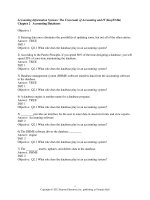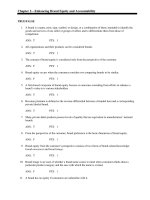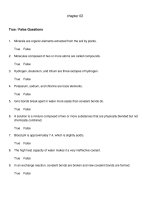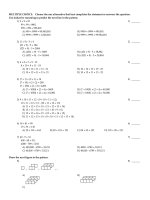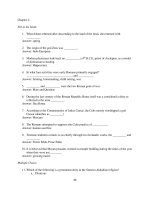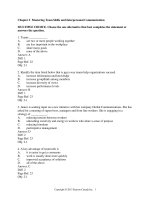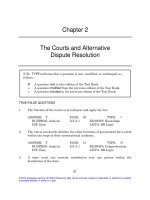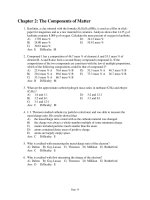Essentials of abnormal psychology third canadian edition 3rd edition nevid test bank
Bạn đang xem bản rút gọn của tài liệu. Xem và tải ngay bản đầy đủ của tài liệu tại đây (430.19 KB, 99 trang )
Chapter 2 Test Item File
Nevid
1) Systems of classification of abnormal behaviour date to ________.
A) ancient times
B) the early 1900s
C) the Renaissance
D) the mid-1800s
Answer: a
Diff: 2
Type: MC
Page Ref: 41
Skill: Factual
2) Each of the following is a reason why it is important to classify abnormal behaviour
EXCEPT ________.
A) it allows researchers to test the effectiveness of new medical treatments such
as drugs
B) it allows mental health professionals to label people who engage in unpopular
or different behaviours than the majority of a population
C) it helps clinicians predict future behaviour
D) it helps researchers identify populations with similar patterns of abnormal
behaviour
Answer: b
Diff: 2
Type: MC
Page Ref: 41
Skill: Factual
3) The most widely used means of assessment is the ________.
A) projective test
B) intelligence test
C) interview
D) actuarial test
Answer: c
Diff: 1
Type: MC
Page Ref: 41
Skill: Factual
4) The intake interview provides an opportunity for the clinician to ________.
A) learn more about the client's presenting problem and history
B) gain an in-depth understanding of the dynamics in a client's life
C) attempt a specific therapeutic intervention to resolve the client's problem
D) gather the client’s demographic information
Answer: a
Diff: 1
Type: MC
Page Ref: 42
Skill: Factual
5) Which of the following is NOT one of the three general types of clinical interviews?
A) an unstructured interview
B) an understructured interview
C) a semi-structured interview
D) a structured interview
Copyright © 2013 Pearson Canada Inc.
1
Chapter 2 Test Item File
Answer: b
Diff: 1
Nevid
Type: MC
Page Ref: 42
Skill: Factual
6) When interviewing, Richard likes to use his own style of questioning rather than
following a standard format. He is using the ________ type of interview.
A) unstructured
B) superstructured
C) semi-structured
D) structured
Answer: a
Diff: 2
Type: MC
Page Ref: 42
Skill: Applied
7) In a(n) ________ interview, the clinician follows a general outline of questions
designed to gather essential information, but is free to ask the questions in any
particular order and to branch off into other directions in order to follow up clinically
important information.
A) unstructured
B) superstructured
C) semi-structured
D) structured
Answer: c
Diff: 1
Type: MC
Page Ref: 42
Skill: Conceptual
8) When Dr. Bond interviews some of her clients, she uses a standardized format that
includes a preset series of questions in a particular order. She is using a __________
format.
A) unstructured
B) quasi-structured
C) semi-structured
D) structured
Answer: d
Diff: 2
Type: MC
Page Ref: 42
Skill: Applied
9) Spontaneity is a major advantage of the ________ interview.
A) unstructured
B) superstructured
C) semi-structured
D) structured
Answer: a
Diff: 1
Type: MC
Page Ref: 42
Copyright © 2013 Pearson Canada Inc.
Skill: Factual
2
Chapter 2 Test Item File
Nevid
10) Lack of standardization tends to reduce the ________ of the unstructured interview as
a diagnostic tool.
A) reliability
B) validity
C) coherency
D) appropriateness
Answer: a
Diff: 2
Type: MC
Page Ref: 42
Skill: Factual
11) Standardized interviews are also known as ________ interviews.
A) unstructured
B) superstructured
C) semi-structured
D) structured
Answer: d
Diff: 1
Type: MC
Page Ref: 42
Skill: Conceptual
12) ________ interview techniques increase the reliability of diagnostic clinical
judgments.
A) Standardized
B) Structured
C) Unstructured
D) Spontaneous
Answer: a
Diff: 2
Type: MC
Page Ref: 42
Skill: Factual
13) The SCID represents a(n) ________.
A) actuarial assessment tool
B) projective test
C) standardized interview technique
D) mental status examination
Answer: c
Diff: 2
Type: MC
Page Ref: 42
Skill: Factual
14) The SCID includes ________.
A) a series of declarative statements
B) open-ended questions
C) closed-ended questions
D) both open- and closed-ended questions
Answer: d
Diff: 2
Type: MC
Page Ref: 42
Copyright © 2013 Pearson Canada Inc.
Skill: Factual
3
Chapter 2 Test Item File
Nevid
15) Which of the following is NOT a general category of a mental status examination?
A) psychosocial history
B) appearance
C) level of awareness
D) mood
Answer: a
Diff: 2
Type: MC
Page Ref: 43
Skill: Factual
16) Psychological tests are structured methods of assessment that are used to evaluate
________.
A) affect
B) motivation
C) goals
D) traits
Answer: d
Diff: 2
Type: MC
Page Ref: 43
Skill: Conceptual
17) Intelligence tests are used in assessment of abnormal behaviour for each of the
following reasons EXCEPT ________.
A) they can identify genetic differences in intelligence among clients from
differing racial and ethnic backgrounds
B) they can help diagnose mental retardation
C) they can be used to assess intellectual impairment due to organic mental
disorders
D) they provide a profile of a client's intellectual strengths and weaknesses in
order to develop a treatment plan suited to the client's competencies
Answer: a
Diff: 3
Type: MC
Page Ref: 43
Skill: Factual
18) The capacity to understand the world and the resourcefulness to cope with its
challenges is one definition of ________.
A) psychological affect
B) emotional maturity
C) intelligence
D) creativity
Answer: c
Diff: 1
Type: MC
Page Ref: 43
Skill: Conceptual
19) The Binet-Simon scale yields a score called a(n) ________.
A) intelligence quotient
B) basal age
Copyright © 2013 Pearson Canada Inc.
4
Chapter 2 Test Item File
Nevid
C) mental age
D) aptitude level
Answer: c
Diff: 2
Type: MC
Page Ref: 43
Skill: Factual
20) The formula for an IQ is ________.
A) IQ=CA/MA × 100
B) IQ=MA/CA × 100
C) IQ=[MA x CA] /100
D) IQ= [MA x 100]/CA
Answer: b
Diff: 1
Type: MC
Page Ref: 43
Skill: Factual
21) The Stanford-Binet scale yields a(n) ________.
A) intelligence quotient
B) basal age
C) mental age
D) aptitude level
Answer: a
Diff: 1
Type: MC
Page Ref: 43
Skill: Factual
22) An IQ score is based on ________.
A) a summative score of correct answers on the test
B) the relationship between a person’s basal age and mental age
C) the relationship between a person’s basal age and chronological age
D) the relationship between a person’s mental age and chronological age
Answer: d
Diff: 2
Type: MC
Page Ref: 43
Skill: Conceptual
23) The Stanford-Binet is an example of a(n) ________.
A) mental status examination
B) projective test
C) intelligence test
D) personality test
Answer: c
Diff: 1
Type: MC
Page Ref: 43
Skill: Factual
24) Two children take the Stanford-Binet test. They both obtain the same mental-age
scores. However, the first child is much younger than the second child who took the
test. How will this affect the score that each child receives?
A) The younger child will obtain a lower IQ score.
Copyright © 2013 Pearson Canada Inc.
5
Chapter 2 Test Item File
Nevid
B) The younger child will obtain a higher IQ score.
C) Both children will obtain the same IQ score.
D) Neither child can receive an IQ score from the Stanford-Binet test.
Answer: b
Diff: 2
Type: MC
Page Ref: 43
Skill: Applied
25) The mean score of an IQ test is ________.
A) 50
B) 100
C) 150
D) 200
Answer: b
Diff: 1
Type: MC
Page Ref: 43
Skill: Factual
26) The amount by which a person's performance on an IQ test differs from the norms for
others in his or her age group is called ________ IQ.
A) difference
B) variance
C) deviation
D) performance
Answer: c
Diff: 2
Type: MC
Page Ref: 43
Skill: Conceptual
27) Each of the following is an advantage to computerized clinical interviews, as
compared with human interviews, EXCEPT ________.
A) computers can be programmed to analyze nonverbal behaviours more
accurately than humans are able to do
B) computers can be programmed to ask a specific set of questions in
predetermined order
C) some clients are less embarrassed relating sensitive personal issues to a
computer
D) computerized interviews can free clinicians to spend more time offering direct
clinical services
Answer: a
Diff: 3
Type: MC
Page Ref: 44
Skill: Factual
28) Brief diagnostic interviews using the telephone have been found to achieve
__________ results to a human interview.
A) relatively the same
B) less positive
C) increased positive
D) profoundly less positive
Copyright © 2013 Pearson Canada Inc.
6
Chapter 2 Test Item File
Answer: a
Diff: 2
Nevid
Type: MC
Page Ref: 44
Skill: Conceptual
29) In remote and northern regions of Canada, __________ between therapists and
clients has been found useful.
A) correspondence
B) email
C) video-conferencing
D) texting
Answer: c
Diff: 1
Type: MC
Page Ref: 44
Skill: Factual
30) According to your text, CASPAR is a(n) ________.
A) projective test
B) actuarial assessment test
C) standardized clinical interview technique
D) computerized clinical interview technique
Answer: d
Diff: 2
Type: MC
Page Ref: 44
Skill: Factual
31) Which of the following is NOT true of computerized interview programs?
A) They achieve similar results to human interviewers using a more intensive
interview protocol.
B) Clients report more problems to the computer than they do to human
interviewers.
C) The majority of these programs have been designed to substitute for a live
therapist.
D) Clients appear to be more willing to share problems with a computer that they
are embarrassed about or unwilling to report to a human.
Answer: c
Diff: 3
Type: MC
Page Ref: 44
Skill: Factual
32) A review of research suggests that the best computer programs are ________.
A) not as good as humans at either obtaining information from a client or reaching
an accurate diagnosis
B) as good as humans at obtaining information from a client, but not as good at
reaching an accurate diagnosis
C) as good as humans at reaching an accurate diagnosis, but not as good at
obtaining information from a client
D) as good as humans at obtaining information from a client and at reaching an
accurate diagnosis
Copyright © 2013 Pearson Canada Inc.
7
Chapter 2 Test Item File
Answer: d
Diff: 2
Nevid
Type: MC
Page Ref: 44
Skill: Factual
33) A review of research on computer interviews indicates that they are ________
expensive and ________ time-efficient than human interviews.
A) less; less
B) more; less
C) less; more
D) more; more
Answer: c
Diff: 2
Type: MC
Page Ref: 44
Skill: Factual
34) The IQ test designed to measure both verbal and performance areas of intelligence is
the ________ scale.
A) Binet-Simon
B) Stanford-Binet
C) Wechsler
D) Terman
Answer: c
Diff: 1
Type: MC
Page Ref: 45
Skill: Factual
35) Cindy’s assessment revealed significant verbal strengths. The test used was the
__________.
A) Wechsler
B) BDI
C) MMPI
D) TAT
Answer: a
Diff: 3
Type: MC
Page Ref: 45
Skill: Applied
36) About ________ % of the IQ scores of any population on the Wechsler scales lie
within the range of 90–110.
A) 30
B) 50
C) 70
D) 90
Answer: b
Diff: 2
Type: MC
Page Ref: 45
Skill: Factual
37) About ________ % of the IQ scores of any population on the Wechsler scales are
above 130 or below 70.
A) 1
Copyright © 2013 Pearson Canada Inc.
8
Chapter 2 Test Item File
Nevid
B) 5
C) 10
D) 15
Answer: b
Diff: 2
Type: MC
Page Ref: 45
Skill: Factual
38) Robin was labelled as “intellectually deficient” after being administered the Wechsler
intelligence test. His IQ would have been scored as below _________.
A) 10
B) 30
C) 50
D) 70
Answer: d
Diff: 2
Type: MC
Page Ref: 45
Skill: Applied
39) Wechsler labelled those with IQ scores above ________ as “very superior.”
A) 130
B) 160
C) 190
D) 220
Answer: a
Diff: 2
Type: MC
Page Ref: 45
Skill: Factual
40) Which is NOT a subscale of the WISC?
A) general knowledge
B) vocabulary
C) digit span
D) block design
Answer: a
Diff: 2
Type: MC
Page Ref: 45
Skill: Factual
41) The most widely used multidimensional self-report inventory is the ________.
A) MMPI
B) BDI
C) WAIS
D) SCII
Answer: a
Diff: 2
Type: MC
Page Ref: 47
Skill: Factual
42) Self-report personality inventories are also called ________.
A) projective tests
Copyright © 2013 Pearson Canada Inc.
9
Chapter 2 Test Item File
Nevid
B) subjective tests
C) introjective tests
D) objective tests
Answer: d
Diff: 2
Type: MC
Page Ref: 47
Skill: Conceptual
43) A test that is closely tied to the DSM-IV Axis I and II categories is the __________.
A) MMPI
B) PAI
C) Wechsler
D) TAT
Answer: b
Diff: 2
Type: MC
Page Ref: 47
Skill: Conceptual
44) Ellen takes a self-report test that asks her to look over a list of adjectives and check
the ones which apply to her. The test is a(n) ________ test.
A) projective
B) subjective
C) introjective
D) objective
Answer: d
Diff: 2
Type: MC
Page Ref: 47
Skill: Applied
45) Ellen takes a self-report test that contains a list of questions, each asking her to decide
which of two statements is more true for her. This test is a(n) ________ test.
A) projective
B) subjective
C) introjective
D) objective
Answer: d
Diff: 2
Type: MC
Page Ref: 47
Skill: Applied
46) Tests such as the MMPI use a(n) ________ format.
A) projective
B) open-ended
C) forced-choice
D) narrative
Answer: c
Diff: 2
Type: MC
Page Ref: 47
Skill: Factual
47) The MMPI is an example of a(n) ________.
Copyright © 2013 Pearson Canada Inc.
10
Chapter 2 Test Item File
Nevid
A) projective test
B) structured interview technique
C) IQ test
D) objective test
Answer: d
Diff: 1
Type: MC
Page Ref: 47
Skill: Factual
Page Ref: 47
Skill: Factual
48) The MMPI is a(n) ________ test.
A) intelligence
B) projective
C) personality
D) visual-motor
Answer: c
Diff: 1
Type: MC
49) The MMPI was constructed primarily on the basis of ________.
A) clinical data
B) naturalistic observation
C) a rational approach
D) structured interviews
Answer: a
Diff: 2
Type: MC
Page Ref: 47
Skill: Factual
50) Scales that measure the degree to which someone attempts to “fake good” or “fake
bad” on the MMPI are called ________.
A) diagnostic scales
B) content scales
C) validity scales
D) clinical scales
Answer: c
Diff: 2
Type: MC
Page Ref: 49
Skill: Conceptual
51) Blind interpretation is when the administrator of an assessment doesn’t know the
__________.
A) diagnosis of the client
B) type of test being administered
C) client’s age, sex, and level of education
D) reasons why the client is being assessed
Answer: c
Diff: 2
Type: MC
Page Ref: 48
Copyright © 2013 Pearson Canada Inc.
Skill: Conceptual
11
Chapter 2 Test Item File
Nevid
52) Each of the following is an advantage to self-report inventories EXCEPT ________.
A) they are easy and economical to administer
B) they can be scored with high inter-rater reliability
C) they are nearly immune to response bias problems
D) they have a quantified basis for interpreting test responses
Answer: c
Diff: 3
Type: MC
Page Ref: 49
Skill: Factual
53) Each of the following is a limitation to self-report inventories EXCEPT ________.
A) they possess low inter-rater reliability
B) they rely on clients as the source of their data
C) they tell us little about possible unconscious processes
D) they may be limited to relatively high-functioning persons who can read well
and respond to verbal material
Answer: a
Diff: 2
Type: MC
Page Ref: 49
Skill: Factual
54) A client at a mental health clinic is given a test in which she is asked to describe a
series of ambiguous-looking ink blots. The test she is taking is a(n) ________ test.
A) intelligence
B) objective
C) projective
D) neuropsychological
Answer: c
Diff: 1
Type: MC
Page Ref: 49
Skill: Applied
55) Projective tests are based upon ________ theories.
A) psychodynamic
B) humanistic
C) cognitive
D) social learning
Answer: a
Diff: 2
Type: MC
Page Ref: 50
Skill: Conceptual
56) The TAT is an example of a(n) ________ test.
A) forced-choice
B) objective
C) projective
D) intelligence
Answer: c
Diff: 1
Type: MC
Page Ref: 50
Copyright © 2013 Pearson Canada Inc.
Skill: Factual
12
Chapter 2 Test Item File
Nevid
57) The Rorschach test is an example of a(n) ________ test.
A) forced-choice
B) objective
C) projective
D) intelligence
Answer: c
Diff: 1
Type: MC
Page Ref: 50
Skill: Factual
58) Which of the following is a projective test?
A) the MMPI
B) the WAIS
C) the MCMI
D) the TAT
Answer: d
Diff: 2
Type: MC
Page Ref: 50
Skill: Factual
59) The Rorschach test consists of ________ inkblots.
A) 5
B) 10
C) 15
D) 20
Answer: b
Diff: 2
Type: MC
Page Ref: 50
Skill: Factual
60) Amy takes a Rorschach test. Her responses tend to be based solely on minor details
of the inkblots. She is likely to be diagnosed with ________ tendencies.
A) depressed
B) passive-aggressive
C) hysteric
D) obsessive-compulsive
Answer: d
Diff: 3
Type: MC
Page Ref: 50
Skill: Applied
61) Each of the following is a criticism of the Rorschach EXCEPT ________.
A) there is a lack of empirical research to support the interpretation of particular
responses
B) it is not useful as a means of gathering information about the ways in which
clients construct meaning from unstructured or ambiguous situations
C) the interpretation of clients' responses is not objective
D) it lacks a well-accepted standardized scoring procedure
Copyright © 2013 Pearson Canada Inc.
13
Chapter 2 Test Item File
Answer: b
Diff: 2
Nevid
Type: MC
Page Ref: 50
Skill: Factual
62) The Thematic Aptitude Test was developed by ________.
A) Murray
B) Termin
C) Wechsler
D) Bandura
Answer: a
Diff: 2
Type: MC
Page Ref: 50
Skill: Factual
63) The TAT is composed of a series of cards ________.
A) containing nonsense syllables
B) containing ambiguous inkblots
C) with open-ended statements like “My favourite food is ...”
D) depicting ambiguous scenes
Answer: d
Diff: 1
Type: MC
Page Ref: 51
Skill: Factual
64) Each of the following is a criticism of the TAT EXCEPT ________.
A) it may exert too strong a “stimulus pull” for clients' answers to be truly based
on internalized perceptions or projections
B) its appeal among clinicians is particularly low
C) it lacks a widely accepted standardized scoring procedure
D) the interpretation of clients' responses is not objective
Answer: b
Diff: 2
Type: MC
Page Ref: 51
Skill: Factual
65) Various methods of ________ assessment help researchers and clinicians evaluate
whether or not behavioural problems reflect underlying organic conditions or brain
damage.
A) neuropsychological
B) neurophysiological
C) actuarial
D) clinical
Answer: a
Diff: 2
Type: MC
Page Ref: 51
Skill: Factual
66) The Luria Nebraska Test Battery reveals ________.
A) patterns of responses suggesting unconscious conflicts or repressed memories
B) patterns of skills deficits that are suggestive of particular sites of brain damage
Copyright © 2013 Pearson Canada Inc.
14
Chapter 2 Test Item File
Nevid
C) a profile of someone's personal and professional areas of interests
D) visual and auditory perceptual skills
Answer: b
Diff: 2
Type: MC
Page Ref: 51
Skill: Factual
67) Each of the following is true of the Luria Nebraska Test Battery EXCEPT ________.
A) it tests a wide range of skills
B) it is more efficiently administered than many other similar tests, such as the
Halstead-Reitan Battery
C) it has been proven to have extremely high reliability
D) it reveals patterns of skills deficits suggestive of sites of organic brain damage
Answer: c
Diff: 2
Type: MC
Page Ref: 51
Skill: Factual
68) The ________ approach holds that psychological tests reveal signs of reasonably
stable traits or dispositions that largely determine the individual's behaviour.
A) cognitive
B) psychometric
C) behavioural
D) neuropsychological
Answer: b
Diff: 2
Type: MC
Page Ref: 52
Skill: Conceptual
69) Trait-based tests such as the MMPI and the Rorschach are based upon the ________
approach.
A) cognitive
B) psychometric
C) behavioural
D) neuropsychological
Answer: b
Diff: 2
Type: MC
Page Ref: 52
Skill: Applied
70) The ________ model treats test results as samples of behaviour that occur in specific
situations rather than signs of underlying personality types or traits.
A) Gestalt
B) psychometric
C) behavioural
D) actuarial
Answer: c
Diff: 2
Type: MC
Page Ref: 52
Copyright © 2013 Pearson Canada Inc.
Skill: Conceptual
15
Chapter 2 Test Item File
Nevid
71) The behavioural interview, more so than the general clinical interview, focuses on the
________ that relate to the problem.
A) genetic predispositions
B) person variables
C) situational factors
D) childhood factors
Answer: c
Diff: 1
Type: MC
Page Ref: 52
Skill: Factual
72) The hallmark technique of behavioural assessment is ________.
A) direct observation
B) analogue measurement
C) self-monitoring
D) the structured interview
Answer: a
Diff: 2
Type: MC
Page Ref: 52
Skill: Conceptual
73) Each of the following is an advantage to direct observation as an assessment
technique EXCEPT ________.
A) there is usually a consensus in defining problems in behavioural terms
B) observations can be videotaped for more extensive analysis of behaviour
patterns
C) it does not rely on clients' self-reports
D) it can suggest appropriate strategies for intervention
Answer: a
Diff: 3
Type: MC
Page Ref: 52
Skill: Factual
74) Each of the following is a disadvantage to direct observation as an assessment
technique EXCEPT ________.
A) observer drift
B) reactivity
C) observer response bias
D) reliance on clients' self-reports
Answer: d
Diff: 3
Type: MC
Page Ref: 52
Skill: Factual
75) Each of the following is a disadvantage to direct observation as an assessment
technique EXCEPT ________.
A) reactivity
B) lack of consensus in defining problems in behavioural terms
C) it does not, in itself, suggest strategies for intervention
D) observer drift
Copyright © 2013 Pearson Canada Inc.
16
Chapter 2 Test Item File
Answer: c
Diff: 2
Nevid
Type: MC
Page Ref: 52
Skill: Factual
76) Jeremiah is asked when he feels anxious, where he when he feels anxious, how often
he feels anxious, and under what circumstances he feels anxious in his assessment.
This would most likely be done in a __________ assessment.
A) behavioural
B) cognitive
C) neuropsychological
D) personality
Answer: a
Diff: 3
Type: MC
Page Ref: 52
Skill: Applied
77) A psychologist visits Natalie’s home to observe the interaction between Natalie and
her parents. The psychologist is completing a(n)__________ assessment.
A) cognitive
B) behavioural
C) eclectic
D) mental status
Answer: b
Diff: 3
Type: MC
Page Ref: 52
Skill: Applied
78) Each of the following is a problem with self-monitoring EXCEPT ________.
A) reactivity
B) some clients are unreliable and do not keep accurate records of targeted
behaviour
C) some clients underreport undesirable behaviours
D) it does not teach clients to assume primary responsibility for their own
behaviour
Answer: d
Diff: 2
Type: MC
Page Ref: 53
Skill: Factual
79) In self-monitoring, a period of time preceding the implementation of a treatment is
called ________.
A) a starting point
B) a baseline
C) an observational bias
D) a set point
Answer: b
Diff: 2
Type: MC
Page Ref: 53
Copyright © 2013 Pearson Canada Inc.
Skill: Conceptual
17
Chapter 2 Test Item File
Nevid
80) Behaviours such as food intake, hair pulling, and cigarette smoking are well suited
for __________.
A) self-monitoring
B) direct observation
C) behavioural interviews
D) home observation
Answer: a
Diff: 3
Type: MC
Page Ref: 53
Skill: Applied
81) Daphne agrees to keep a record of how many times she has urges to engage in selfinjurious behaviour. This form of gathering information is __________.
A) indirect observation
B) a behavioural motivation study
C) an independent observation study
D) self-monitoring
Answer: d
Diff: 2
Type: MC
Page Ref: 53
Skill: Factual
82) “Contrived measures” refer to ________.
A) analogue techniques
B) direct observation techniques
C) behavioural rating scales
D) self-monitoring techniques
Answer: a
Diff: 2
Type: MC
Page Ref: 54
Skill: Conceptual
83) Sierra attends an assertiveness training class. As part of the class, she is expected to
role-play assertive behaviour. This technique is also known as a(n) ________.
A) in vivo method
B) analogue
C) holistic approach
D) experimental approach
Answer: b
Diff: 2
Type: MC
Page Ref: 54
Skill: Applied
84) The behavioural Approach Task is a popular ________ measure.
A) experimental
B) in vivo
C) analogue
D) psychometric
Answer: c
Copyright © 2013 Pearson Canada Inc.
18
Chapter 2 Test Item File
Diff: 3
Nevid
Type: MC
Page Ref: 54
Skill: Conceptual
85) The behavioural Approach Task is used to help clients deal with ________.
A) generalized anxiety
B) phobias
C) conversion disorders
D) cognitive dissonance
Answer: b
Diff: 3
Type: MC
Page Ref: 54
Skill: Factual
86) In discussing his child's problem behaviours with a therapist, Fred is asked to review
a checklist of more than 100 specific problem behaviours and place a check mark next
to each behaviour that applies to his child. This checklist is known as a ________.
A) behavioural rating scale
B) behavioural approach task
C) social desirability scale
D) social reactivity scale
Answer: a
Diff: 2
Type: MC
Page Ref: 54
Skill: Applied
87) Hillary visits a therapist to deal with her anxiety and depression. The therapist
explores her thoughts, beliefs, and attitudes and attempts to replace her self-defeating
thoughts with rational, self-enhancing thought patterns. Her therapist is using a
________ assessment approach.
A) psychometric
B) behavioural
C) cognitive
D) Gestalt
Answer: c
Diff: 3
Type: MC
Page Ref: 54
Skill: Applied
88) André is asked to keep a diary to record his thoughts and then bring it to his therapy
session. This is a technique used in the ________ assessment approach.
A) psychometric
B) behavioural
C) humanistic
D) cognitive
Answer: d
Diff: 3
Type: MC
Page Ref: 54
Skill: Applied
89) Candace is asked to role-play how she would approach her parents to tell them she
failed a course. This is an example of _________.
Copyright © 2013 Pearson Canada Inc.
19
Chapter 2 Test Item File
Nevid
A) behavioural rating
B) an in vitro exercise
C) cognitive restructuring
D) an analogue or contrived measure
Answer: d
Diff: 3
Type: MC
Page Ref: 54
Skill: Applied
90) Helen is asked to carry a diary to record when she has negative thoughts about
herself. Her therapist is using a(n) __________ approach.
A) cognitive
B) behavioural
C) analogue or contrived measure
D) in vitro
Answer: a
Diff: 3
Type: MC
Page Ref: 54
Skill: Applied
91) Andrew is asked to rate the frequency of times he says “I hate myself.” His therapist
is using a(n) __________.
A) automatic thoughts questionnaire
B) thought record
C) thought diary
D) analogue or contrived questionnaire
Answer: d
Diff: 3
Type: MC
Page Ref: 55
Skill: Applied
92) Hillary visits a therapist to help deal with her anxiety and depression. The therapist
administers a rating scale in which she rates the weekly frequency and degree of
conviction of 30 negative thoughts. The scale Hillary was given was probably the
________.
A) Dysfunctional Attitudes Scale
B) Daily Record of Dysfunctional Thoughts
C) Automatic Thoughts Questionnaire
D) Cognitive Checklist
Answer: c
Diff: 3
Type: MC
Page Ref: 55
Skill: Applied
93) Anxious people tend to sweat, and that sweating can be measured by ________.
A) electroencephalograph
B) electromyograph
C) electrocardiograph
D) electrodermal response
Copyright © 2013 Pearson Canada Inc.
20
Chapter 2 Test Item File
Answer: d
Diff: 2
Nevid
Type: MC
Page Ref: 56
Skill: Conceptual
94) Electrical activity of the brain is measured by the ________.
A) electroencephalograph
B) electromyograph
C) electrocardiograph
D) electrodermal response
Answer: a
Diff: 1
Type: MC
Page Ref: 56
Skill: Factual
95) Changes in muscle tension associated with anxiety can be measured by means of an
________.
A) electroencephalograph
B) electromyograph
C) electrocardiograph
D) electrodermal response
Answer: b
Diff: 2
Type: MC
Page Ref: 56
Skill: Conceptual
96) ________ devices allow clinicians to monitor clients' blood pressure at intervals
throughout the day.
A) Galvanic skin response
B) Electroencephalographic
C) Electromyographic
D) Ambulatory
Answer: d
Diff: 2
Type: MC
Page Ref: 56
Skill: Factual
97) Lang (1968) suggested that fear or anxiety consists of three different response
systems. Each of the following is one of those response systems EXCEPT
________.
A) emotional
B) behavioural
C) physiological
D) verbal
Answer: a
Diff: 3
Type: MC
Page Ref: 56
Skill: Factual
98) Bryan is being assessed for anxiety and his therapist uses a test to assess his muscle
tension. The test used would most likely be the _________ test.
A) galvanic skin response
Copyright © 2013 Pearson Canada Inc.
21
Chapter 2 Test Item File
Nevid
B) electrodermal response
C) electromyography
D) ambulatory blood pressure
Answer: c
Diff: 3
Type: MC
Page Ref: 56
Skill: Applied
99) Lang suggested that fear or anxiety consists of response systems that include
__________.
A) behaviour and verbal
B) behaviour and physiological
C) psychological, behavioural, and physiological
D) verbal, behavioural, and physiological
Answer: d
Diff: 3
Type: MC
Page Ref: 56
Skill: Factual
100) Karl wants to examine brain wave patterns associated with psychological disorders
such as schizophrenia, and with physiological problems related to tumours and brain
damage. He should probably use a(n) ________.
A) CAT scan
B) PET scan
C) EEG
D) MRI
Answer: c
Diff: 3
Type: MC
Page Ref: 57
Skill: Applied
101) An imaging technique that uses an X-ray beam and radiation to reveal abnormality
in the shape or structure of various parts of the brain is a ________.
A) CT scan
B) PET scan
C) BEAM
D) NMR
Answer: a
Diff: 2
Type: MC
Page Ref: 57
Skill: Conceptual
102) An imaging technique that uses a radioactive tracer to measure the functioning of
various parts of the brain is ________.
A) a CAT scan
B) a PET scan
C) BEAM
D) MRI
Answer: b
Copyright © 2013 Pearson Canada Inc.
22
Chapter 2 Test Item File
Diff: 2
Nevid
Type: MC
Page Ref: 57
Skill: Conceptual
103) An imaging technique that uses radio waves and a strong magnetic field to create an
image of the brain is ________.
A) a CAT scan
B) a PET scan
C) MRI
D) BEAM
Answer: c
Diff: 2
Type: MC
Page Ref: 57
Skill: Conceptual
104) Doug is asked to solve a riddle. A technique that can show which parts of his brain
are active would be the __________.
A) MRI
B) CT scan
C) PET
D) EEG
Answer: a
Diff: 3
Type: MC
Page Ref: 57
Skill: Applied
105) A technique that uses a computer to analyze brain wave patterns to reveal areas of
relative activity and inactivity from moment to moment is ________.
A) a CAT scan
B) a PET scan
C) MRI
D) BEAM
Answer: d
Diff: 2
Type: MC
Page Ref: 58
Skill: Conceptual
106) Andrea has epilepsy and her physician wants to accurately locate the source of her
seizures. A __________ test would be able to give the most accurate information.
A) BEAM
B) MEG
C) CT scan
D) PET scan
Answer: d
Diff: 3
Type: MC
Page Ref: 58
Skill: Applied
107) Which statement best represents a person whose identity is NOT defined in terms of
a disorder?
A) Jane is schizophrenic.
B) Jane has schizophrenia.
Copyright © 2013 Pearson Canada Inc.
23
Chapter 2 Test Item File
Nevid
C) Jane is a person with schizophrenia.
D) Jane appears to be schizophrenic.
Answer: c
Diff: 3
Type: MC
Page Ref: 59
Skill: Conceptual
108) In the DSM system, abnormal behaviours are classified as ________.
A) abnormalities
B) behaviour abnormalities
C) mental disorders
D) mental diseases
Answer: c
Diff: 2
Type: MC
Page Ref: 59
Skill: Factual
109) The current classification system used by most mental health professionals to assess
abnormal behaviour is the ________.
A) DSM-I
B) DSM-II
C) DSM-III
D) DSM-IV
Answer: d
Diff: 1
Type: MC
Page Ref: 59
Skill: Factual
110) The ________ has been adopted as the Canadian standard for coding, reporting, and
tracking health information.
A) DSM
B) DSM-IV
C) DSM-IV-TR
D) ICD-10
Answer: d
Diff: 2
Type: MC
Page Ref: 59
Skill: Factual
111) The DSM system is often criticized for relying too much on the ________ model of
abnormal behaviour.
A) psychodynamic
B) medical
C) sociocultural
D) social learning
Answer: b
Diff: 2
Type: MC
Page Ref: 59
Copyright © 2013 Pearson Canada Inc.
Skill: Factual
24
Chapter 2 Test Item File
Nevid
112) Each of the following is considered an abnormal behaviour pattern by the DSM
system EXCEPT ________.
A) experiencing emotional distress
B) engaging in behaviour that is statistically deviant
C) experiencing impaired functioning
D) engaging in behaviour that risks personal suffering, pain, or death
Answer: b
Diff: 3
Type: MC
Page Ref: 59
Skill: Conceptual
113) Which of the following is NOT true of the DSM system?
A) It treats abnormal behaviours as symptoms of underlying disorders.
B) It assumes that abnormal behaviours result from biological causes.
C) It does not subscribe to any single theory of abnormality.
D) It can be used by practitioners of diverse theoretical persuasions.
Answer: b
Diff: 2
Type: MC
Page Ref: 59
Skill: Factual
114) The DSM system is used to classify ________.
A) groups
B) theoretical perspectives
C) social norms
D) disorders
Answer: d
Diff: 1
Type: MC
Page Ref: 59
Skill: Conceptual
115) In the DSM system, disorders are classified on the basis of ________.
A) clinical features and behaviour patterns
B) their frequency within clinical populations
C) underlying theoretical mechanisms
D) their response rates to various treatment methods
Answer: a
Diff: 2
Type: MC
Page Ref: 60
Skill: Factual
116) Wakefield recently proposed that the term disorder be conceptualized as ________.
A) statistically deviant behaviour
B) harmful dysfunction
C) physiologically-based problems
D) a label society imposes on people who are different
Answer: b
Diff: 1
Type: MC
Page Ref: 60
Copyright © 2013 Pearson Canada Inc.
Skill: Conceptual
25
